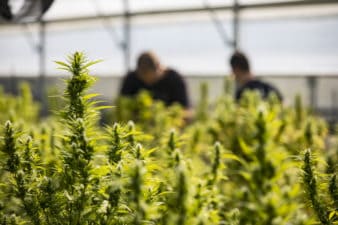Aurora Cannabis (TSX:ACB)(NYSE:ACB) shares are currently trading at a rather lofty 500 times price-to-earnings multiple.
But are fears that Canada’s second-largest publicly traded cannabis stock is overvalued overblown?
Let’s take a closer look at why ACB’s current price-to-earnings multiple might not have much to do with the company’s potential as an attractive long-term growth prospect.
Aurora’s market capitalization right now sits at about $10 billion, which means that at a forward price-to-earnings ratio of 500 times the market is currently expecting the company to earn somewhere in the neighbourhood of $200 million next year ($10 billion divided by 500).
Going back to its most recently reported third quarter for a second, Aurora produced just 15,590 kilograms of cannabis, generating a loss of $158 million in the process.
Those production levels were actually a 99% increase compared to the 7,822 kilograms it had produced in the prior quarter, so it’s clearly making improvement, but then again, there’s also a long way for it to go.
Because despite producing a little more than 15,000 kg over the past quarter, its production capacity right now sits at 150,000 kilograms annually. Longer term, it’s expecting that figure to reach 625,000 kilograms annually by as early as December 31, 2020.
Obviously, there will be a lot riding on its ability to execute the build-out of its planned production facilities and ramping up those operations in an orderly (and profitable) manner. If it can do that, I think the future could be very bright for the company and its loyal shareholders.
Call me crazy, but I believe that even despite the loss it posted in during the third quarter, in the grand scheme of things, this company, and particularly in light of the massive scale of its operations, should eventually be able to grow, cultivate, and sell its cannabis product at a profit.
What that profit will be, the truth is, no one really knows for sure, because we’re still far too early in the game to be able to tell.
But I’d like to believe that a 10% or even 15% or 20% net profit margin would be reasonable for a company that at least so far is fairly well protected by a government in charge of granting licenses to approved growers.
If you were to believe (as I do) that ACB could deliver $1 in net profit for every gram of cannabis it produced, the company, right now trading at a valuation near $10 billion, is actually trading at just 16 times those forecasted profits.
Now that sounds like a much more promising investment opportunity, doesn’t it?
Foolish bottom line
It’s also important to keep in mind that the shares of companies from other industries with attractive long-term prospects also typically tend to receive a premium from the market.
Shares of companies like Brookfield Renewable Partners and Sienna Senior Living trade at forward price-to-earnings multiples of 54 times and 98 times, respectively.
Make no mistake about it, there could very well be a lot of volatility ahead for those holding ACB shares, but when you consider the potential not yet tapped into of alternative applications like edibles, adult-beverages, and international markets, this might not be an idea you’d want to bail out on.
Making the world smarter, happier, and richer.







